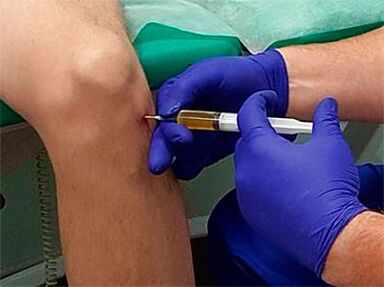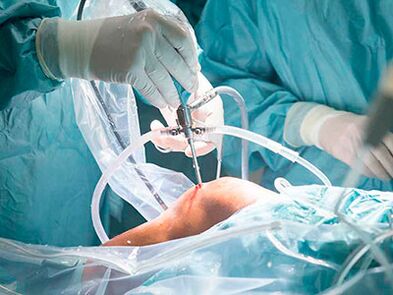Orthopedic traumatologists carry out specialized diagnostics (radiation, laboratory), conservative therapy (medications, intra-articular injections, PRP therapy, cellular technologies of regenerative medicine, etc.) and high-tech surgical treatment of gonarthrosis (arthrosis of the knee joint) - arthroscopy, endoprosthetics, corrective osteotomy.
Gonarthrosis is observed in every tenth person over 55 years of age and in every fourth of these patients it leads to disability.
Up to 80% of patients with osteoarthritis of the knee joints report decreased quality of life.
The duration of operation of a modern endoprosthesis of the knee joint 10 years after surgery is 99%, after 15 years – 95%, after 20 years – 90%.
Why does osteoarthritis of the knee joint occur?
- Most often, the cause of the development of the disease is knee injuries, especially repeated ones (meniscal injuries, dislocations, fractures, bruises, etc.).
- Joint microtraumas frequently repeated during sports training, with constant “standing” work, have a similar effect.
- Excess body weight creates increased axial load and destroys the joint.
- The degenerative-dystrophic process in the joint can also occur after inflammatory diseases (gout arthritis, psoriasis, rheumatoid arthritis).
- Endocrine diseases, hormonal changes (for example, menopause), metabolic disorders aggravate pathological changes in the joint.
Main symptoms of knee joint pain
- With grade 1 gonarthrosis - at the initial stage of the disease, periodic pain occurs in the knee joint after exercise (walking, running, standing for a long time), which disappears after rest.At this stage, there is practically no joint deformation or mobility restrictions;
- Gradually, the pain becomes more frequent and intensified, especially when going up and down stairs, as well as when starting to walk after sitting for a long time (initial pain);
- In grade 2 gonarthrosis, knee pain during exercise becomes constant, disappears only after a long rest, the patient limps when walking;
- When moving, a crushing sensation appears in the joint.The range of movements in the knee joint is limited (when “fully” bending, sharp pain appears);
- When examining the joint area, you may notice swelling and deformation;
- In 3rd degree AOD of the knee joint, which corresponds to severe gonarthrosis, the pain in the joint is uncomfortable even at rest, it does not allow you to fall asleep, the range of movements decreases significantly, patients walk with their legs bent and there is a pronounced deformation of the knee joint (O- or X-shaped legs).

Diagnosis
- A survey and examination by an orthopedic traumatologist reveals typical signs of degenerative dystrophic joint disease (pain on palpation, limited mobility, crepitus, deformity, joint effusion).
- An x-ray examination of the knee joint is carried out (radiographic narrowing of the joint space, determination of the presence of osteophytes, subchondral sclerosis) and, if necessary, a computed tomography of the joint.
- Ultrasound examination of the joint can detect thinning of the joint cartilage, changes in the ligaments, muscles, soft tissues around the joint, inflammatory effusion in the joint cavity and changes in the menisci.
- The most accurate information is provided by MRI of the knee joint, which reveals changes in cartilage and bone tissue, ligaments, menisci, synovial membrane, making it possible to differentiate post-traumatic arthrosis of the knee joint and arthritis, a tumor process.
- Diagnostic puncture and arthroscopy of the knee joint, as well as laboratory tests of synovial fluid obtained during the procedure, are widely used in the diagnosis of joint diseases.
Treatment of gonarthrosis
Treatment for osteoarthritis of the knee joint depends on the stage of the disease.
Conservative

In the early stages of DOA, successful complex conservative treatment is possible, which aims to relieve inflammation, restore cartilage, eliminate pain and restore full joint function:
- Therapeutic and protective regime - it is necessary to limit the load on the joint and ensure rest.
- Conservative drug treatment of gonarthrosis:
- use of analgesics, non-steroidal anti-inflammatory drugs, chondroprotectors;
- local use of medicines in the form of ointments, gels;
- intra-articular injection - intra-articular administration of an individually selected combination of drugs, which may include hormonal agents to quickly relieve inflammation, drugs based on hyaluronic acid to replenish synovial fluid, etc.;
- PRP therapy - intra-articular injections of PRP (own platelet-rich plasma).
- Regenerative medicine methods - intra-articular injections of autologous cells of the stromal-vascular fraction, cells - precursors of cartilaginous tissue, obtained from the adipose tissue itself.
- Massage, physiotherapy, manual therapy.
- Mandatory use of therapeutic physical training with a set of exercises aimed at improving blood circulation in the joint and increasing range of movement.
Surgical

Knee arthroscopy
In case of pronounced changes in the joint (advanced osteoarthritis, traumatic defects), orthopedic traumatologists carry out surgical treatment of arthrosis of the knee joint using arthroscopy (surgeries on the meniscus, cartilage, removal of the “joint rat”, synovectomy, etc.).
Knee arthroplasty
If other treatment methods are ineffective, we perform knee replacement with modern prostheses from the best manufacturers in the world.This is a reliable way to relieve the patient's pain and restore mobility and a decent quality of life.
Nowadays, there is no point in enduring pain and discomfort caused by joint pain.Modern medical technologies make it possible to help treat arthrosis of the knee joint at almost any stage.Contact your doctor and take advantage of the options available.



































